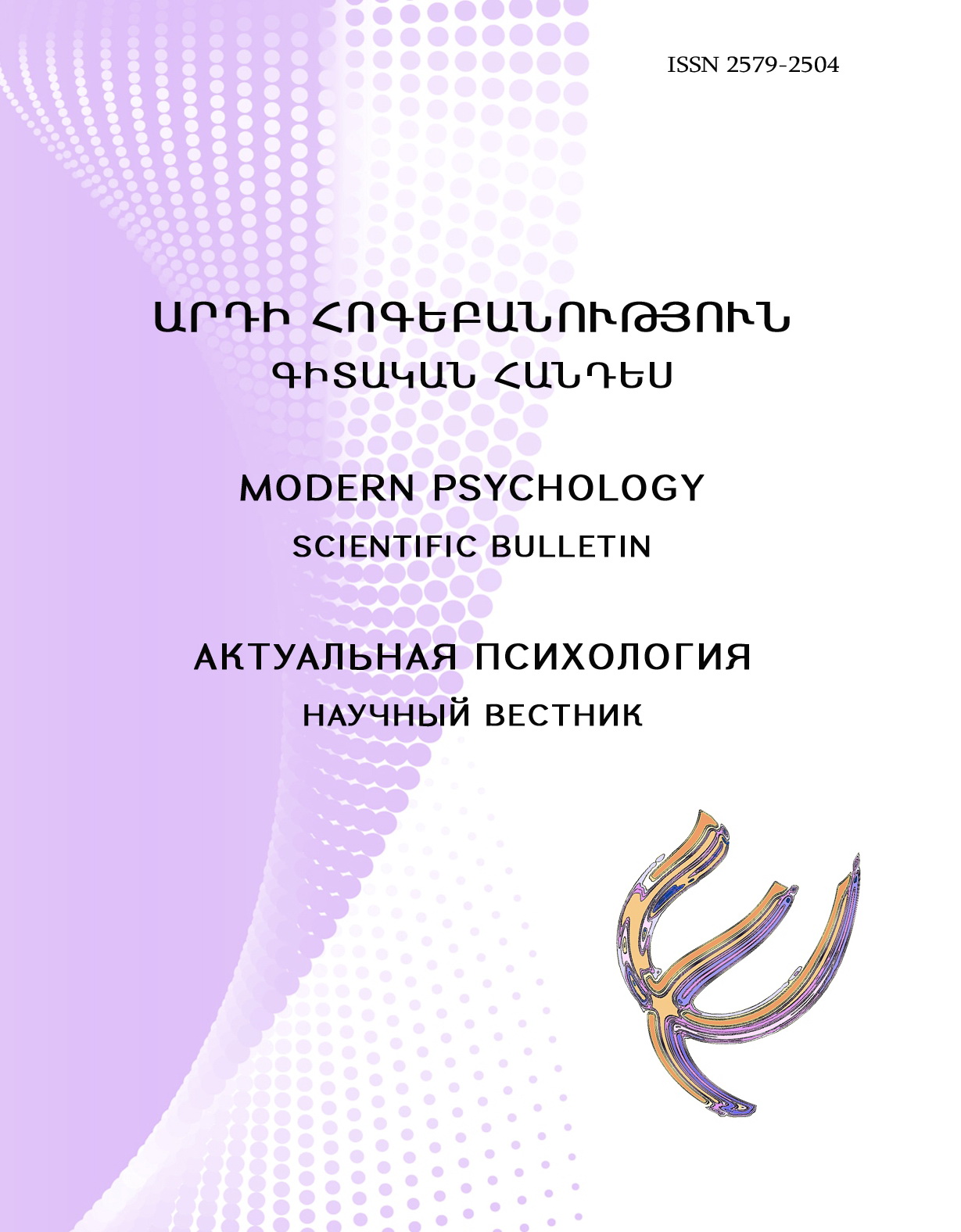MEASUREMENT INVARIANCE ACROSS AGE GROUPS OF THE ARMENIAN INSTRUMENT OF CULTURAL LOGICS OF HONOR, DIGNITY AND FACE
DOI:
https://doi.org/10.46991/SBMP/2023.6.1.039Keywords:
Cultural logics of honor, face and dignity, validation, measurement invariance, multiple group confirmatory analysisAbstract
This article is part of ongoing studies aimed at validating the measurement model of honor, face, and dignity in the Armenian language. Psychometric equivalence of cultural logics of honor, face, and dignity across age groups was assessed.
In total, 382 participants aged 18 to 47 (Mage=24.03, SD=5.721, 68.5% were women) were included in the analysis. Two age groups (youngsters, aged 18 to 25, n=273 and adults, aged 26 to 47, n=109) were defined for measurement invariance analysis. Multiple group confirmatory analyses were conducted within four model parameters: configural, metric, scalar, and residual invariance. Full invariance was achieved for the cultural logic of face across two age groups. Partial residual invariance was established for the cultural logic of honor. The cultural logic of dignity was partially invariant based on metric and scalar levels.
These findings provide a psychometric basis for the valid comparisons of the means of cultural logics of honor, dignity and face across age groups. This enriches our understanding of the Armenian instrument's performance and makes it a useful tool for social-psychological studies examining the prevalence of these cultural logics and their associations with other variables such as moral values and self-construal. Further analysis can focus on exploring the peculiarities of the non-invariant items.
References
Arnett, J. J. (2004). Emerging adulthood: The winding road from the late teens through the twenties. New York: Oxford University Press, 270 p.
Aslani, S., Ramirez-Marin, J., Semnani-Azad, Z., Brett, J. M., & Tinsley, C. 2013. Dignity, face, and honor cultures: Implications for negotiation and conflict management. In M. Olekalns & W. L. Adair (Eds.), Handbook of research on negotiation: 249–282. Northampton, MA: Edward Elgar Publishing.
Brown, T. A. (2006). Confirmatory factor analysis for applied research. New York, NY: The Guilford Press.
Cheung, G. W., & Rensvold, R. B. (2002). Evaluating goodness-of-fit indexes for testing measurement invariance. Structural Equation Modeling, 9(2), 233–255. https://doi.org/10.1207/S15328007SEM0902_5
Friedrichs, J. 2016. An intercultural theory of international relations: How self-worth underlies politics among nations. International Theory, 8(1): 63–96.
Grigoryan A., Khachatryan, N., Smith, P.B. (in review for IACCP 2022 Proceedings). Two dimensions of dignity and honor: From adaptation to the development of measurement in the Armenian language.
Khachatryan N., Grigoryan A. The experience of adaptation of cultural dimensions by examining Dignity, Honour and Face cultures // (Retrieved from https://www.elibrary.ru/item.asp?id=43007810&pf=1 13.02.2023).
Leung, A. K.-Y., & Cohen, D. (2011). Within- and between-culture variation: Individual differences and the cultural logics of honor, face, and dignity cultures. Journal of Personality and Social Psychology, 100(3), 507–526. https://doi.org/10.1037/a0022151
Maitner, A. T., DeCoster, J., Andersson, P. A., Eriksson, K., Sherbaji, S., Giner-Sorolla, R., … Wu, J. (2022). Perceptions of Emotional Functionality: Similarities and Differences Among Dignity, Face, and Honor Cultures. Journal of Cross-Cultural Psychology, 53(3–4), 263 288. https://doi.org/10.1177/00220221211065108]
Putnick, D. L., & Bornstein, M. H. (2016). Measurement Invariance Conventions and Reporting: The State of the Art and Future Directions for Psychological Research. Developmental review : DR, 41, 71–90.https://doi.org/10.1016/j.dr.2016.06.004
Rodriguez Mosquera, P. M. R., Manstead, A. S., & Fischer, A. H. 2002. The role of honour concerns in emotional reactions to offences. Cognition & Emotion, 16(1): 143–163.
Serobyan A․, Grigoryan A., Khachatryan N․ And'i dispozicional gc'er & social-mshakowt'ayin koghmnoroshowmner. hogechap'oghakan gorc'iqneri teghaynacowm: Gitamet'odakan d'er'nark. -Er., EPH hrat., 2021, 128 e'j.
Smith, P. B., Easterbrook, M. J., Koc, Y., Lun, V. M.-C., Papastylianou, D., Grigoryan, L., … Chobthamkit, P. (2021). Is an emphasis on dignity, honor and face more an attribute of individuals or of cultural groups? Cross-Cultural Research, 55(2–3), 95–126. https://doi.org/10.1177/1069397120979571
Smith, P.B., Easterbrook, M.J., Blount, J., Koç, Y., Harb, C., Torres, C.V., … Rizwan, M.A. (2017). Culture as perceived context: An exploration of the distinction between dignity, face and honor cultures. Acta de Investigación Psicológica, 7, 2568-2576.
Yao, J., Ramirez-Marin, J.Y., Brett, J.M., Aslani, S., & Semnani-Azad, Z. (2017). A measurement model for dignity, face, and honor cultural norms. Management and Organization Review, 13, 713 - 738.
Downloads
Published
How to Cite
Issue
Section
License
Copyright (c) 2023 Ani Grigoryan

This work is licensed under a Creative Commons Attribution-NonCommercial 4.0 International License.



